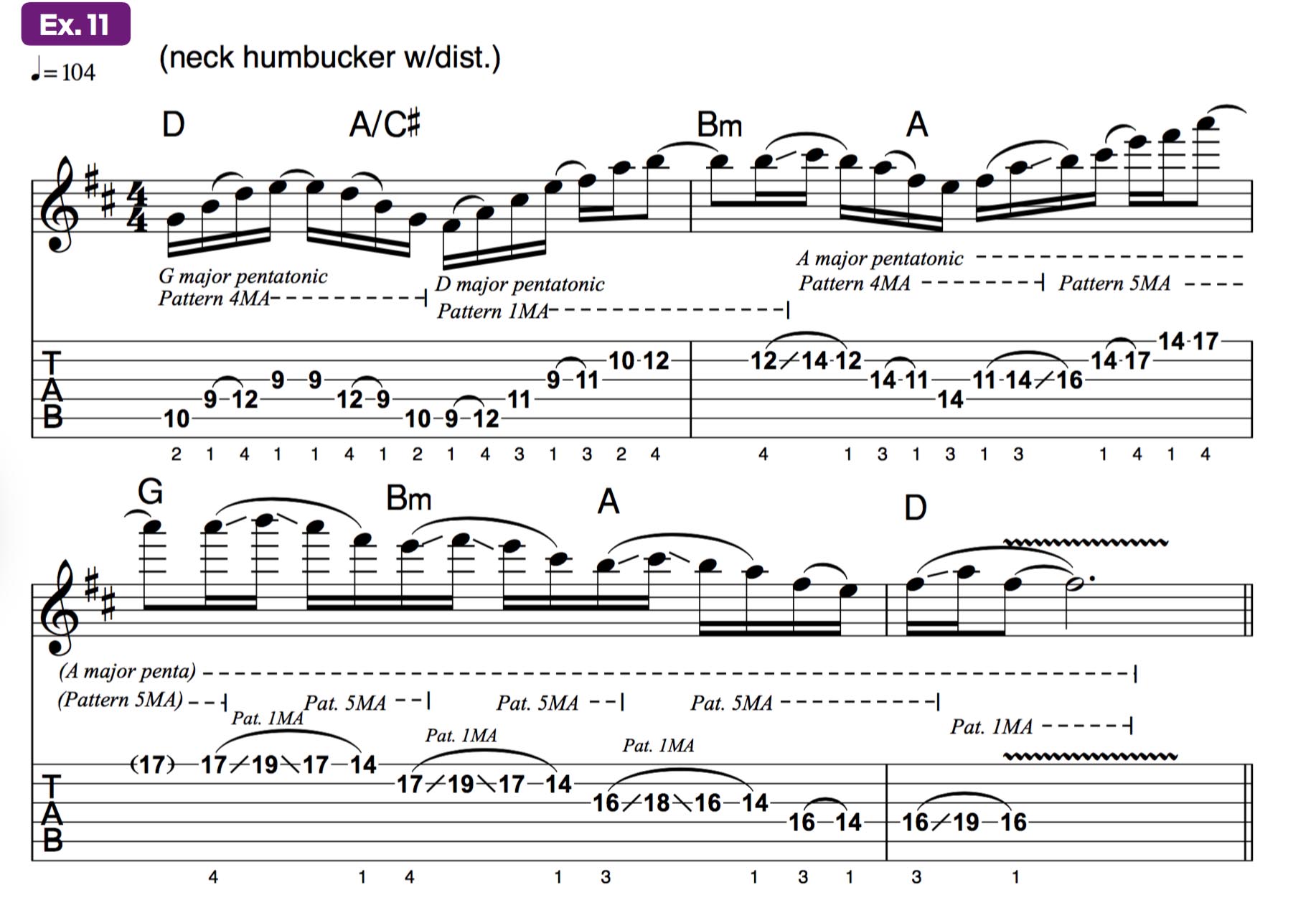
Did you know that every major and natural minor scale contains within its structure six different pentatonic scales – three major and three minor? Once understood and utilized, this multi-pentatonic awareness can open up the fretboard in many convenient and inventive ways.
For starters, it can help you break out of the uninspiring solitary-position-playing rut, sending your fingers to places on the fretboard you never thought they could go. It can also help you create unusual-sounding, “off the beaten path” phrases and easily craft melodic and rhythmic motifs. It can even open the floodgates for “inside/outside” passages.
In this two-part lesson, I’ll explain and demonstrate how this can be done in appealing ways that will hopefully inspire you to take the musical ball and run with it in new and interesting directions.
This first installment will cover the foundation of the overlapping interrelationships between pentatonic scales and major and natural minor scales, and include examples in the styles of various players. Next month, in Part 2, we’ll look at some cool ways that pentatonic licks can be used to create colorful modal implications.
Pentatonic Patterns
We’ll begin by surveying the fretboard patterns that will be used in this lesson. Examples 1a-e illustrate the five minor pentatonic “box” patterns, or shapes, each of which have two notes per string.
The circled notes are the roots, or tonics. This visualization allows the patterns to be easily moved to any key on the fretboard. For the purposes of this lesson, the patterns are named 1mi through 5mi.
It’s important to note that the five patterns line up along the fretboard to form a chain of overlapping shapes, with the “upper” notes – meaning those closest to the guitar body – overlaying the “lower” notes – those closest to the nut – of the next higher pattern, as you can see here.
All the latest guitar news, interviews, lessons, reviews, deals and more, direct to your inbox!
Examples 2a-e depict the major pentatonic patterns. These are labeled 1MA through 5MA to distinguish them from their minor pentatonic counterparts. Looking at these two sets of examples and rows of shapes, notice that each major pentatonic shape resembles that of the minor pentatonic one above and to the right of it, the only difference being the root-note orientation.
Diatonic Substitution Theory
The basic principle of this lesson is that three minor pentatonic scales and three major pentatonic scales reside within every major scale and each of its modes. They all line up and correspond to the triad harmony of the first six steps of the major scale.
Take the C major scale, for instance (C, D, E, F, G, A, B). The scale harmony is C (C, E, G), Dm (D, F, A), Em (E, G, B), F (F, A, C), G (G, B, D), Am (A, C, E), and Bdim (B, D, F).
The pentatonic process comes into play in this manner: The major chords (I, IV, and V: C, F, and G, respectively) receive major pentatonics built from the root, and the minor chords (ii, iii, and vi: Dm, Em, and Am) align with minor pentatonic scales built from that root.
- I chord (C): C major pentatonic scale (C, D, E, G, A)
- ii chord (Dm): D minor pentatonic scale (D, F, G, A, C)
- iii chord (Em): E minor pentatonic scale (E, G, A, B, D)
- IV chord (F): F major pentatonic scale (F, G, A, C, D)
- V chord (G): G major pentatonic scale (G, A, B, D, E)
- vi chord (Am): A minor pentatonic scale (A, C, D, E, G)
- vii chord (Bdim): B minor pentatonic with a flatted 5th (B, D, E, F, A).
Viewing this same process from the perspective of the relative A natural minor scale (A, B, C, D, E, F, G), it stands to reason that there are also three minor pentatonics and three major pentatonics embedded within its structure:
- i chord (Am): A minor pentatonic scale (A, C, D, E, G)
- iidim chord (Bdim): B minor pentatonic with a flatted 5th (B, D, E, F, A)
- bIII chord (C): C major pentatonic scale (C, D, E, G, A)
- iv chord (Dm): D minor pentatonic scale (D, F, G, A, C)
- v chord (Em): E minor pentatonic scale (E, G, A, B, D)
- bVI chord (F): F major pentatonic scale (F, G, A, C, D)
- bVII chord (G): G major pentatonic scale (G, A, B, D, E)
This again translates to the minor chords (i, iv, and v) corresponding to minor pentatonic scales, the major chords (bIII, bVI, and bVII) aligning with major pentatonics, and the oddball biidim can be enveloped with an “adjusted” minor pentatonic scale that flats the 5th degree (b5). Okay, that was the hard and tedious part. Now let’s take this scale theory off the drawing board and into the woodshed.
Pentatonic Substitution Tactics For The Natural Minor Scale
Let’s get rolling with some blues-rock licks all crafted from “Pattern 1mi” pentatonic scale patterns. For the sake of clarity and continuity, we’ll stick to A natural minor scale tonalities based on the principles discussed above.
Example 3 begins life high up the neck in Pattern 1mi of the A minor pentatonic scale (A, C, D, E, G), transposes down a 4th to the same pattern of E minor pentatonic (E, G, A, B, D), and reaches fruition a whole step down in (you guessed it) Pattern 1mi of the D minor pentatonic scale (D, F, G, A, C).
Look back over the example and notice that every note of the A natural minor scale has been incorporated into the lick. In reality, the entire melody can be played using a 17th-position A natural minor scale pattern, but somehow it doesn’t have quite the same effect. Try it out and be the judge.
Example 4 takes an opposite approach, traveling up the fretboard, pattern by pattern, from A minor pentatonic at the 5th fret, to D and E minor pentatonic at the 10th and 12th frets, respectively, culminating at the 17th fret in A minor pentatonic.
This passage is based on 6th intervals, which can be tricky to plot out along the fretboard in standard fashion. By comparison, using this pentatonic process, it becomes almost a no-brainer.
Example 5 is a double-stop-fueled riff that zips up the neck along the A-D-G string set. As in the previous example, the A string is used to segue from pattern to pattern.
Be careful not to let the notes barred with the index finger ring beyond their prescribed duraton. Rather, roll your finger across the fretted notes, pressing firmly against a string only when picking it.
Example 6 is a hard-rocking, “super-legato” run that incorporates all manner of hammer-ons, pull-offs, and slides.
Notice that this phrase stays within the confines of “neighboring patterns” (close in proximity) of D and E minor pentatonic. Make sure to follow the fret-hand fingerings at the bottom of the tab staff for maximum precision, and try an all-downstroke attack for extra oomph.
Example 7 is a shape-oriented phrase based on an index-finger “roll-over” maneuver – from the 5th fret of the low E string to the 5th fret of the A string – that is replicated on different string sets in the subsequent patterns (the D and G strings at the 10th fret, and the G and B strings at the 12th fret).
Example 8 is another shape-oriented example. This one, however, stays put on the same string set (D-G-B) as it zigzags its way down the fretboard.
Example 9 is a flashy lick that couples a series of hammer-on maneuvers launched with open-string attacks. The hammer-ons lie within the Pattern 1mi boxes at the 5th, 10th, and 12th frets. The launching pads are the “zero fret” notes of an open-position, E minor pentatonic “Pattern 1mi” box.
Wrapping up this A natural minor-based section, it’s important to note that, from a melodic aspect, the A minor pentatonic scale brings out the chord tones of an Am7 chord: the root (A), b3rd (C), 5th (E), and b7th (G), with the 4th, or 11th (D), serving as an added passing tone.
The E minor pentatonic scale also contains the root, 5th, b7th, and 4th of the Am7 chord but adds a 9th (B). The D minor pentatonic scale needs to be used with care here.
Although it includes the strong chord tones of Am7, specifically the root, b3rd, and b7th, it also houses the 4th and b6th (F), the latter of which can be the most “dangerous” chord tone to hang on in most situations and should be used with discretion.
Major-Scale Applications
Let’s shift gears and explore some major tonality possibilities. Example 10 is a sweet-sounding R&B-style offering that’s inspired by players such as Steve Cropper, Cornell Dupree, and John Mayer and features a chord progression based on the I (E), IV (A), and V (B) chords of the E major scale (E, F#, G#, A, B, C#, D#).
The tonic (E) bass-note pedal tone reinforces the E major tonal center of the progression. The natural tendency is to start soloing with the complete E major scale, but the example opts for pentatonic substitution instead.
As we witnessed with the previous minor pentatonic scales based on a minor key’s i, iv, and v chords, this example employs the major pentatonics based on the I, IV, and V chords of the major scale. In this case, we have E major pentatonic (E, F#, G#, B, C#), A major pentatonic (A, B, C#, E, F#), and B major pentatonic (B, C#, D#, F#, G#).
All the moves are molded from Pattern 1MA of each pentatonic scale (refer back to Ex. 2a).
Example 11 is a melodic rock example (think Eric Johnson, Neal Schon, or Tom Scholz) that’s cast over an active chord progression harmonized from the D major scale (D, E, F#, G, A, B, C#).
Here again, the I, IV, and V major pentatonic scales – D major pentatonic (D, E, F#, A, B), G major pentatonic (G, A, B, D, E), and A major pentatonic (A, B, C#, E, F#) – are called into service.
This is a carefully crafted passage that puts several patterns (1MA, 4MA, and 5MA) into play. You can refer back to Examples 2a-e for visual aids to the patterns.











